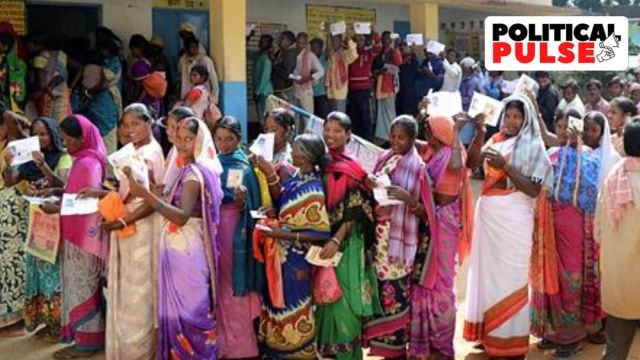
Between LS and Assembly polls in Jharkhand, surge in women coming out to vote
With women voters having played a key role in propelling the Hemant Soren-led government to its second consecutive term – a first in the state’s 24-year-old history – women MLAs are likely to get their fair share in the state Cabinet, sources within the Jharkhand Mukti Morcha (JMM) said.
Twelve women MLAs have been elected to the Jharkhand Assembly this time, of whom eight belong to the INDIA bloc (five to the Congress and three to the JMM) and four to the BJP.
Election Commission data shows that the number of women voters in Jharkhand saw a significant jump in the six-month period between the Lok Sabha and Assembly polls. While the increase in the number of male voters was 17,777, around 2.5 lakh women were added to the electoral rolls in the period between the two elections.
“Our base was the 2019 polls, from when around 19 lakh women were added to the electoral rolls. We intended to target that section of the electorate and we succeeded,” sources involved in the formulation of the JMM government’s Maiyya Samman Yojana, which is believed to have proved a winner with women voters, said.
In terms of voting too, women outnumbered men. While 91.16 lakh women cast their votes, the number for men stood nearly 6 lakh behind. In terms of voting percentage, 70.46% of the women voters cast their ballot, while 65% of the men did.
In the Lok Sabha elections held five months ago, where the NDA did well, the gap between women and men voters was much lesser – 87.11 lakh and 83.85 lakh, respectively. Even the gap between how many women and men voters turned out was much lower too, 68.67% for women, and 63.79% for men. The surge in the gap in the Assembly polls was largely because many more women came out to vote this time than in the Lok Sabha elections – in absolute numbers, 7.3 lakh more women voted compared to 1.8 lakh more men.
In fact, women outnumbered men in terms of voting in as many as 72 of the state’s 81 Assembly constituencies this time. Of these, 48 seats were won by the INDIA bloc (29 JMM, 14 Congress, 4 RJD and 1 CPI-ML-L), and 22 by the NDA (BJP 20, AJSU Party 1, LJP (Ram Vilas) 1).
The trend of more women voters also held true for constituencies which saw high polling, for example Nala (80.56%, the highest in the state); ST-reserved Maheshpur (78.92%); Saraikella (70%); and Gandey (67%). While the JMM’s Kalpana Soren and Stephen Marandi won from Gandey and Maheshpur, respectively, the winner in Saraikella was JMM-turned-BJP leader Champai Soren.
In contrast, in Khijri, which saw just 52.46% polling, women voting percentage at 51% was 4 percentage points behind men. The Congress’s Rajesh Kachhap won this seat by over 29,000 votes.
The Maiyya Samman Yojana, introduced this year, provides a monthly assistance of Rs 1,000 to underprivileged women between the 18-50 age group. Months ahead of the polls, the Soren government had approved a hike in the aid to Rs 2,500 from December.
Why dating apps are out and meetup platforms are inSubscriber Only
Bada Naam Karenge review: This Rajshri series is plain creaky
Dali was fascinated by Indian myths: Curator Christine ArgilletSubscriber Only
'You need to acknowledge where you come from': Khushi KapoorSubscriber Only
Watch theatre director Abhishek Majumdar’s Kavan, a political cabaretSubscriber Only
Vultures, now have more than carrion to feed on —Subscriber Only
Srijit Mukherji talks about alternate cinemaSubscriber Only
Ralph Fiennes, Stanley Tucci's thriller unspools along expected lines
Mother Nature’s mindboggling nano-engineering

 Posts
Posts Sign up as a Teacher
Sign up as a Teacher







